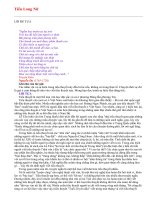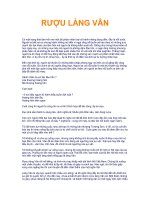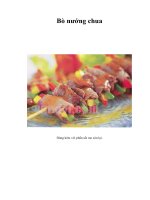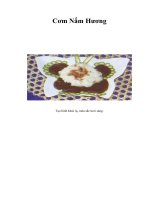Tài liệu Overlapping Silly Faces doc
Bạn đang xem bản rút gọn của tài liệu. Xem và tải ngay bản đầy đủ của tài liệu tại đây (476.43 KB, 9 trang )
SILLY FACES
Brenda Hoddinott
E-02 BEGINNER: PERSPECTIVE ONE
Pretend you’re inside a spaceship, flying through the galaxy, while looking outward into space
through a square window. Suddenly, you see a whole bunch of silly faces floating toward you!
They appear bigger and bigger the closer they move toward you.
In this fun lesson, a group of silly faces seem to be floating through space. Overlapping, as a
component of geometric perspective, is introduced as a means of creating depth.
Four elements of perspective are used in this lesson: Overlapping: Most silly faces in this
project overlap others; Size Differences: The farther away objects are, the smaller they appear to
be; Atmospheric Perspective: The outlines of the faces need to become gradually lighter in
value as they appear to recede into distant space; and Arrangement: Those faces that are closer
to the viewer are drawn closer to the bottom of the drawing space.
This lesson is divided into the following two sections:
Ü INTRODUCTION: An illustrated discussion explores the process of creating the illusion of
three-dimensional reality with four elements of perspective.
Ü OVERLAPPING SILLY FACES: You draw nine overlapping faces, from the closest to the
farthest away, which appear to recede into the distance as they float through space. As for
their individual shapes and facial features – feel free to use your imagination.
Suggested drawing supplies for this project include HB, 2B, and 4B graphite pencils, a vinyl
eraser, a ruler, and good quality drawing paper
This project is recommended for artists of all ages, as well as home schooling,
academic and recreational fine art educators.
9 PAGES – 13 ILLUSTRATIONS
Published by Hoddinott Fine Art Publishers, Halifax, NS, Canada – 2003 (Revised 2006)
Copyright to all articles, images, text, projects, lessons and exercises within this drawing class belong to Brenda Hoddinott and may
not be reproduced or used for any commercial purposes whatsoever without the written permission of Brenda Hoddinott.
Web sites and
2
INTRODUCTION
Suggested drawing supplies for this project include HB, 2B, and 4B graphite pencils, a vinyl
eraser, a ruler, and good quality drawing paper
ILLUSTRATION 02-01
Assume that, in reality, all the
silly faces you are about to
draw are exactly the same size.
However, to create the illusion
of three-dimensional reality,
some need to be drawn large,
while others need to be quite
tiny.
Examine Illustration 02-01 to
get an idea of how the silly
faces should look when
finished. Each is numbered
from 1 to 9, according to the
sequence in which they will be
drawn – 1 is first and 9 last.
Refer to this illustration as you
read about how the following
four elements of perspective are
used to create the illusion of
depth in this specific drawing:
Overlapping: When one object is in front of another, it is obviously closer. Most silly faces
in this project overlap (appear to be in front of) others. Overlapping, as a component of
perspective, gives the illusion of depth in a drawing and refers to the positions of the
subjects, when one visually appears to be in front of another (or others).
A noticeable clue is provided when a section of one seems to be missing. However, it’s not
really missing - the one in front of it is merely blocking your line of vision.
Size differences: The farther away objects are, the smaller they appear to be. As the numbers
get higher from 1 to 9, each face is rendered progressively smaller – number 1 is larger than
number 2 and so on. Number 9 is the smallest of all!
As you progress through each step of this project, make sure every silly face you draw is
slightly smaller than the previous one.
Atmospheric Perspective: The farther an object recedes into the distance, the lighter in
value it seems to become due to the presence of various particles in the atmosphere. Values
are the different shades of gray created in a drawing by various means, such as using
different grades of pencils, varying the density of the shading lines and/or the pressure used
in holding a pencil.
Copyright to all articles, images, text, projects, lessons and exercises within this drawing class belong to Brenda Hoddinott and may
not be reproduced or used for any commercial purposes whatsoever without the written permission of Brenda Hoddinott.
Web sites and
3
In this drawing, the outlines of the faces need to become gradually lighter in value as the
numbers get higher. To create this illusion, use a 4B pencil (dark) to draw number 1 and 2, a
2B pencil (medium) for numbers 3 to 5, and an HB (lighter) for numbers 6 to 9.
Arrangement: When subjects are viewed below the horizon line, objects that are closer need
to be drawn closer to the bottom of the drawing space. The horizon line: (also known as eye
level) refers to an imaginary horizontal line that divides your line of vision when you look
straight ahead.
In this drawing, the horizon line is not marked, but is above the silly faces. Hence, those faces
that are closer to the viewer are drawn closer to the bottom of the drawing space. Conversely,
those that are farthest away are drawn closer to the top of the drawing space. The higher the
numbers, the higher up each face appears within the drawing space.
Drawing space refers to the area in which you render a drawing within a specific perimeter. It
can be the shape of your paper or outlined by any shape you choose, such as a rectangle or
square.
OVERLAPPING SILLY FACES
In this fun lesson, groups of overlapping silly faces appear to recede into the distance as they
float through space. As for their individual shapes and faces – feel free to use your imagination.
1) Draw a square to represent your drawing space.
Your square can be any size you wish. Suggested sizes include 4 inches by 4 inches, 6
inches by 6 inches, or 8 inches by 8 inches.
ILLUSTRATION 02-02
2) Use a wiggly line to draw a big
sideways C in the lower one-
third of your drawing space.
Use a 4B pencil. The line does not
need to have its wiggles the same
as in my drawing.
However, pay attention to its size
and position within the lower
section of the drawing space.
Also note that one end of this line
touches the bottom side of the
square closer to the left than the
right. The other end touches the
right side of the square near the
bottom.
Copyright to all articles, images, text, projects, lessons and exercises within this drawing class belong to Brenda Hoddinott and may
not be reproduced or used for any commercial purposes whatsoever without the written permission of Brenda Hoddinott.
Web sites and
4
Before you attempt to draw these cartoon eyes, you need to be familiar with the names of each
part. Refer to the next drawing and the following terms:
ILLUSTRATION 02-03
A highlight is the brightest area where light
bounces off the surface of the eye.
The iris is the colored circular section of the
eyeball.
The white of the eye is the visible section of
the eyeball.
ILLUSTRATION 02-04
3) Draw eyes on the large face.
Begin by drawing two ovals and then
add a large circle (the iris) in the
upper section of each.
Outline a tiny circle (the highlight0
inside each large circle. highlights
helps make eyes look shiny.
4) Use your 4B pencil to completely
shade in the top half of each eye,
but remember to leave the
highlight white.
ILLUSTRATION 02-05
Don’t worry if your silly
faces don’t look exactly
like mine.
If you wish, you
can use your
imagination and
create your own
eyes (and
mouths) for
each of the nine
silly faces,
Copyright to all articles, images, text, projects, lessons and exercises within this drawing class belong to Brenda Hoddinott and may
not be reproduced or used for any commercial purposes whatsoever without the written permission of Brenda Hoddinott.
Web sites and
5
ILLUSTRATION 02-06
5) Draw an outline of a smaller silly face
behind the first.
This face appears higher within the
drawing space – the top is slightly above
the halfway point of the height of the
square drawing space. Each end touches
the outline of the first. Hence the first
face is overlapping (in front of) this one.
6) Draw the eyes and mouth on the
second silly face.
Note that the eyes and mouth on the
second silly face are at an angle.
ILLUSTRATION 02-07
7) Draw the outline of the third,
even smaller, silly face with a
2B pencil.
8) Add its eyes and mouth.
The eyes and nose on the third
silly face are also at an angle.
ILLUSTRATION 02-08
Take note that the three silly faces are
three different sizes with the largest in
the front, and the smaller ones
appearing to be behind it.
The first one you drew looks closer
than the other two, because it is largest
in size, lowest within the drawing
space, and overlaps the others.









